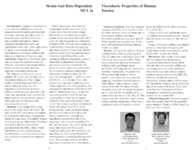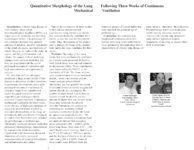| OCR Text |
Show Removal of Fapy-Adenine by the DNA Repair Enzymes Fpg, hOGG1, and yOGG2 Deoxyribonucleic acid (DNA) is a molecule found in every cell and contains the codes for making proteins and directing cellular reproduction. All of the information in DNA is stored using combinations of four bases. The four bases are cytosine (C), thymine (T), guanine (G), and adenine (A). When these bases are damaged, an incorrect base can pair with the mutated base. When an incorrect base is attached, the genetic code is altered. If the DNA is altered, the results to the cell can be very harmful and lead to diseases such as cancer. All cells must therefore have repair enzymes that can correct the mutation before it is passed on to future cells. These enzymes must recognize and repair different forms of damage. Experiments studying substrate recognition are important because they allow insight into how the enzyme performs catalysis. Previous work in this lab using Fpg with the oxidized guanine products 8-oxo-guanine (OG), guanidinohydantoin (Gh), and spiroiminodihydantoin (Sp) has shown that the ability of Fpg to excise the mutagenic base is influenced not only by the damaged base itself, but also by the base opposite the lesion. Fpg excises OG slower from OG:A than from OG:C. The rate of excision from a base pair with A can be increased by replacing the OG with Gh or Sp; however the removal of Gh or Sp from a base pair with C is slower than the removal of OG. Because of these facts, several repair enzymes such as Fpg (MutM), yOGG2, and hOGG1 were studied by running kinetic assays with a mutated adenine base, Fapy-adenine (Fa). The two specific substrates studied were Fa:C and Fa:A. Each enzyme showed a different reactivity with each substrate. Fpg cleaved both Fa:C and Fa:A faster than the other two enzymes. Fpg cleaved Fa:C three times faster than Fa:A. Fa:C was cleaved with hOGG1 approximately 100 times slower than with the Fpg, and did not recognize Fa:A. Fa:C was cleaved with yOGG2 approximately ten times slower than with the Fpg. Fa:C and Fa:A were cleaved at about the same rate by yOGG2. Future experiments on the substrate recognition of Fapy-adenine include more assays with Fa:T and Fa:G as well as kinetics with other repair enzymes. Hillary Workman Class Standing: Senior Major: Chemistry E-mail: hillary.workman@m.cc.utah.edu Faculty Sponsor: Dr. Sheila S. David Department of Chemistry E-mail: david@chemistry.utah.edu |









































